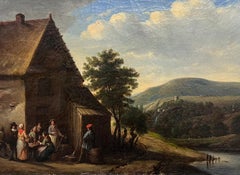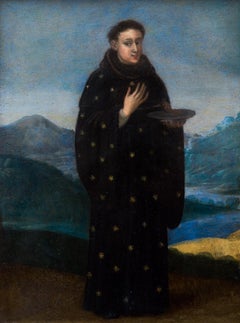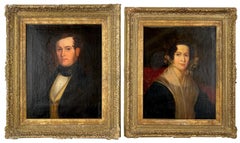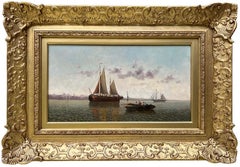19th century Dutch or Flemish school Paintings
to
1
Overall Width
to
Overall Height
to
1
1
1
1
1
1
1
1
1
1
1
1
1
1
784
716
707
703
1
1
Artist: 19th century Dutch or Flemish school
Figures Chatting outside Village Tavern in Mountain Landscape, Period Oil
By 19th century Dutch or Flemish school
Located in Cirencester, Gloucestershire
Dutch/ Flemish School, early 1800's
oil on canvas, framed
framed: 19 x 24 inches
canvas: 13.5 x 18.5 inches
provenance: private collection, France
condition: good and sound condition...
Category
Early 19th Century Old Masters 19th century Dutch or Flemish school Paintings
Materials
Oil, Canvas
Related Items
Allegory of Summer, workshop of Hendrick Van Balen 17th c. Antwerp school
By Hendrick van Balen
Located in PARIS, FR
Allegory of summer, personified by Ceres
Workshop of Hendrick Van Balen
Antwerp School, early 17th century.
Oil on copper,
Dimensions: h. 52 cm, l. 40cm
Antic giltwood frame
Framed dimensions: h. 74 cm, l. 60cm
Very good condition
Our delicately painted work is part of the pictorial tradition that is both allegorical and mythological in vogue in Antwerp, whose leaders are Jan Brueghel the Younger and Hendrick Van Balen. Numerous works emerging from their workshops illustrate mythological subjects, the seasons, the elements, the senses or intertwining the lush landscapes, animals and gods of Olympus.
At the heart of a green landscape dominated in its center by a generous apple tree, the beautiful Ceres, partially dressed in a large blue drape, is wearing a crown of ears of wheat, her symbol of the goddess of the earth and harvests. She holds the sickle in her right hand and carries sheaves of wheat. To her right a nymph holds the cornucopia while puttis pick and offer flowers.
In the foreground are the summer fruits: figs, cherries, apples and lemons. A squirrel munching on cherries symbolizes toil and foresight, themes that are echoed in the work of the harvesters on the wheat fields in the background.
The background is composed of vegetation, on the right a wild rose bush with its branches erect against a tree trunk, in the center of the trees with silvery green foliage.
Our painter, a student of Hendrick Van Balen, finds his inspiration in the works of the master such as this nymph in yellow drapery seen from behind, one of the figures which accompanies many of the master's paintings. The elegant gestures, the flesh...The indisputable influence of Jan Brueghel the Younger is revealed in the treatment of trees and flowers, wild roses, tulips as well as in the still life with the squirrel in the foreground.
The craze for this type of virtuoso painting where the mythological figures are only a pretext to better illustrate the landscape and plant species surrounding them, then generated orders from all over Europe.
Hendrick Van Balen, Flemish painter, born and died in Antwerp (1575-1632). A student of Adam Van Noort, he entered the guild of Saint-Luc in 1593, later trained in Italy and was Van Dyck's first master. He often painted small characters taken from scenes from the Bible or classical mythology, on paintings in which Josse de Momper...
Category
Early 17th Century Old Masters 19th century Dutch or Flemish school Paintings
Materials
Copper
$13,082
H 29.13 in W 23.62 in
Old Master Painting, Flemish School from 1600s, Saint Nicholas of Tolentino
Located in Stockholm, SE
This small Flemish painting, measuring only 24.5 x 18.5 cm and executed on a copper plate, depicts Saint Nicholas of Tolentino. Created in the 17th century, the artist remains unknow...
Category
17th Century Old Masters 19th century Dutch or Flemish school Paintings
Materials
Copper
$4,013 Sale Price
25% Off
H 9.65 in W 7.29 in
The Knight - painting - XVII century
Located in Roma, IT
The Knight is an original oil painting on canvas realized during the XVII century by an anonymous artist.
Provenance: Pecci-Blunt collection. Good condition...
Category
17th Century Old Masters 19th century Dutch or Flemish school Paintings
Materials
Canvas, Oil
Landscape Near Felday, Surrey
By Abraham Hulk the Younger
Located in Hillsborough, NC
Dutch/English artist Abraham Hulk the Younger (1851-1922) is most known for landscapes of the British countryside. This work is one of a pair (the second work is also available by s...
Category
Late 19th Century Old Masters 19th century Dutch or Flemish school Paintings
Materials
Canvas, Oil
$2,240 Sale Price
20% Off
H 27 in W 22.75 in D 2.13 in
Bustling 17th century harbour landscape with fishermen, visitors and merchants
By Mathys Schoevaerdts
Located in Aartselaar, BE
17th Century Flemish Painting "A bustling scene of fishermen, merchants and visitors in a peaceful and picturesque port village”
This intriguing painting offers a wonderful and real...
Category
17th Century Old Masters 19th century Dutch or Flemish school Paintings
Materials
Oil, Canvas
$9,513
H 11.03 in W 13.78 in
Large 17th century Italian old master - Noli me tangere, Christ in the garden
By Pier Francesco Cittadini
Located in Aartselaar, BE
Large 17th Century Italian Old Master, The Garden - Noli me tangere, Pier Francesco Cittadini (attr.)
Description
In the stillness of a garden in bloom, Noli me tangere captures a p...
Category
17th Century Old Masters 19th century Dutch or Flemish school Paintings
Materials
Canvas, Oil
$7,730
H 31.89 in W 40.56 in
Five mid 20th century Italian oil landscapes with figures, castles, Churchs
Located in Woodbury, CT
A very interesting set of five mid-20th-century Italian oils on copper.
All five are classical landscape subjects and are signed Roger, though we don't know which artist with the n...
Category
1950s Old Masters 19th century Dutch or Flemish school Paintings
Materials
Copper
$5,560 Sale Price
20% Off
H 7 in W 5 in
Antique Roman painter - 18th century landscape painting - Wanderers - Italy
Located in Varmo, IT
Roman painter (18th century) - Landscape with wayfarers.
43.5 x 34.5 cm without frame, 58.5 x 49.5 cm with frame.
Antique oil painting on canvas, in a carved and gilded wooden fram...
Category
Early 18th Century Old Masters 19th century Dutch or Flemish school Paintings
Materials
Canvas, Oil
$1,189 Sale Price
44% Off
H 23.04 in W 19.49 in
18th century French Garden or Féte a Bride and musicians playing music
Located in Woodbury, CT
This enchanting 18th-century French fête galante captures the elegance and joy of aristocratic leisure, set amidst a lush garden adorned with flowers. A scene of refined celebration,...
Category
1780s Old Masters 19th century Dutch or Flemish school Paintings
Materials
Canvas, Oil
19th Century English Antique, Two Country farmers drinking beer in a landscape
By George Morland
Located in Woodbury, CT
Attributed to George Morland.
19th Century English Antique, Two Country farmers drinking beer in a landscape.
Wonderful early 19th-century original oil on canvas.
A classic 'Morland' composition as the painter was a big fan of English Pub scenes...
Category
Early 1800s Old Masters 19th century Dutch or Flemish school Paintings
Materials
Canvas, Oil
$3,160 Sale Price
20% Off
H 20 in W 16 in
Antique English 19th century marine scene
By William Anderson
Located in Woodbury, CT
Outstanding English late 18th / early 19th century marine scene by one of Britain's best known and sought after painters.
William (or Wiliam) Anderson (1757 – 27 May 1837) was a Scottish artist specializing in maritime and patriotic themes. He was well-regarded for his detailed and accurate portraits of ships under sail, exhibiting his works annually in London between 1787 and 1811 and then occasionally until 1834. Anderson influenced other artists, notably John Ward and others of the Hull school.
Anderson's early life is obscure, but he is known to have trained as a shipwright before moving to London to become a maritime painter when he was about 30. His training served him well as a painter, providing "a practical nautical knowledge" of his subjects. He earned a reputation for "accuracy and refinement of detail" and was admired for his bright, clear colours. He worked in both oils and watercolours.
He based his style on that of well-known Dutch maritime...
Category
1810s Old Masters 19th century Dutch or Flemish school Paintings
Materials
Oil, Wood Panel
$5,962 Sale Price
25% Off
H 8 in W 10 in
"The Weaver" - Large Scale Navajo Figurative Landscape
Located in Soquel, CA
Stunning large scale and vivid painting of Native American weaver by Northern California artist Helene Minelli (American, 1918-2010), circa 1980s. Signe...
Category
1980s Old Masters 19th century Dutch or Flemish school Paintings
Materials
Canvas, Oil, Stretcher Bars
$3,250 Sale Price
35% Off
H 74 in W 82 in D 2 in
Previously Available Items
Early 19th Century Portrait of Dutch Man and Woman - Pair - Original Oil on Line
By 19th century Dutch or Flemish school
Located in Soquel, CA
Early 19th Century Portrait of Dutch Man and Woman - Pair - Original Oil on Line
Exceptional Dutch School portraits of young man and woman. Some craquelure through due to age. Laid d...
Category
1830s Old Masters 19th century Dutch or Flemish school Paintings
Materials
Linen, Oil, Stretcher Bars
Ships in a Calm Harbor
By 19th century Dutch or Flemish school
Located in Wiscasett, ME
Oil on canvas, signed and dated 1879 in the lower left. I cannot make out the name of the artist, possibly 'R Gounoiut?', but it is very well executed. Most likely French, Belgian, o...
Category
1870s Dutch School 19th century Dutch or Flemish school Paintings
Materials
Oil
Early 19th century Dutch or Flemish River Landscape, figure crossing a bridge
By 19th century Dutch or Flemish school
Located in Woodbury, CT
Wonderfully painted Dutch or Flemish Antique early 19th-century landscape.
This piece has all the quality of the early 19th-century European landscape painters who were so well kno...
Category
1830s Old Masters 19th century Dutch or Flemish school Paintings
Materials
Oil, Wood Panel
Early 19th century Dutch or Flemish River Landscape, figure crossing a bridge
By 19th century Dutch or Flemish school
Located in Woodbury, CT
Wonderfully painted Dutch or Flemish Antique early 19th-century landscape.
This piece has all the quality of the early 19th-century European landscape painters who were so well kno...
Category
1830s Old Masters 19th century Dutch or Flemish school Paintings
Materials
Oil, Wood Panel
19th Century Dutch Or Flemish School paintings for sale on 1stDibs.
Find a wide variety of authentic 19th century Dutch or Flemish school paintings available for sale on 1stDibs. You can also browse by medium to find art by 19th century Dutch or Flemish school in canvas, fabric, oil paint and more. Much of the original work by this artist or collective was created during the 19th century and is mostly associated with the Old Masters style. Not every interior allows for large 19th century Dutch or Flemish school paintings, so small editions measuring 24 inches across are available. 19th century Dutch or Flemish school paintings prices can differ depending upon medium, time period and other attributes. On 1stDibs, the price for these items starts at $1,650 and tops out at $1,650, while the average work can sell for $1,650.




